![]() Mystical
Ethiopia
Mystical
Ethiopia ![]()
Land and Resources | Climate | Culture | Population | History | Historical Places | Religions | Government
Mystical Ethiopia | Addis Ababa | Economy | Emperor Haile Selassie | More Pictures
|
Land and Resources | Climate | Culture | Population | History | Historical Places | Religions | Government Mystical Ethiopia | Addis Ababa | Economy | Emperor Haile Selassie | More Pictures |
|
Population About 80 percent of the inhabitants of Ethiopia support themselves through agriculture, which is largely of a subsistence nature. The population is concentrated heavily in the central plateau region, where agricultural resources are most developed. The ethnic composition is extremely diverse, as a result of racial and linguistic integration that began in ancient times. The population of Ethiopia (1996 estimate) is about 57,171,662, yielding an overall density of about 51 persons per sq km (about 133 per sq mi). The Amhara, who founded the original nation, and the related Tigrayans, both of whom are highland peoples of partly Semitic origin, constitute about 32 percent of the total population. They occupy the northwestern Ethiopian highlands and the area north of Addis Ababa. The Oromo, a pastoral and agricultural people who live mainly in central and southwestern Ethiopia, constitute about 40 percent of the population. The Shangalla, a people in the western part of the country from the border of Eritrea to Lake Turkana, constitute about 6 percent of the population. The Somali, who live in the east and southeast, notably in the Ogaden region, are about equal in number to the Shangalla. The Denakil inhabit the semidesert plains east of the highlands. The nonindigenous population includes Yemenis, Indians, Armenians, and Greeks. Ethiopia like many African countries, is a multi-ethnic state. Many distinctions have been blurred by intermarriage over the years, but many also remain. The differences may be observed in the number of languages spoken - an astonishing 83, falling into four main language groups: Semitic, Cushitic, Omotic an Nilo-Sahara. there are 200 different dialects. The Semitic languages of Ethiopia are related to both Hebrew and Arabic, and derive from Ge'ez, the ecclesiastical language. The principle Semitic language spoken in the north-western and central part of the country is Amharic, which is also the official language of the modern state. Other main languages are Tigrigna, Guragigna, Adarigna, Afan Oromo, Somaligna, Sidamigna, Afarigna, Gumuz, Berta and Anuak. The Tigrigna and Amharic-speaking people of the north an center of the country are mainly agriculturalists, tilling the soil with ox-drawn ploughs and growing teff ( a local millet), wheat, barley, maize and sorghum. The most southerly of the Semithic speakers, the Gurage, are also farmers and herders, but many are also craftsmen. The Gurage grow 'Inset' (false banana), whose root, stem and leaf stalks provide a carbohydrate which, after lengthy preparation, can be made into porridge or unleavened bread. The Cushitic Oromo, formerly nomadic pastoralists, are now mainly engaged in agriculture and, in the more arid areas, cattle-breeding. The Somali, also pastoral nomads, forge a living in hot and arid bush country, while the Afar, semi-nomadic pastorialists and fishermen, are the only people who can survive in the hostile environment of the Danakil Depression. Living near the Omo River are the Mursi, well-known for the large clay discs that the women wear inserted in a slit in their lower lips.
|

|